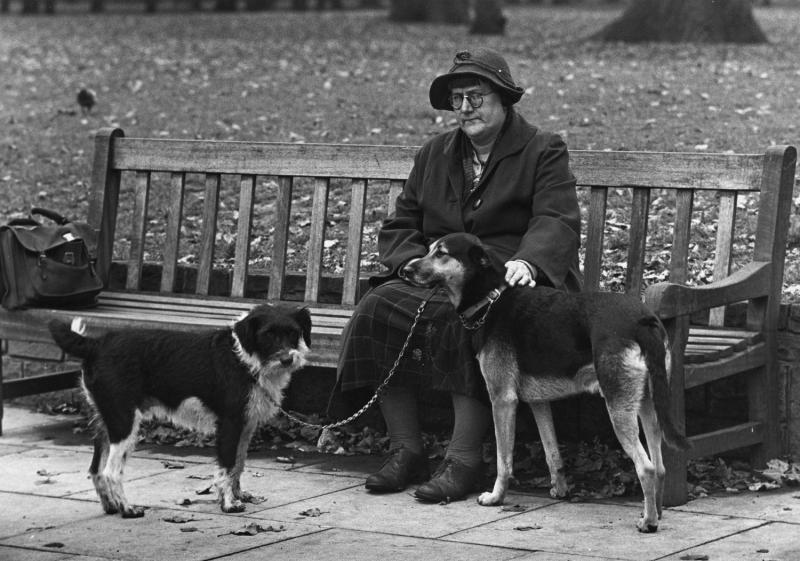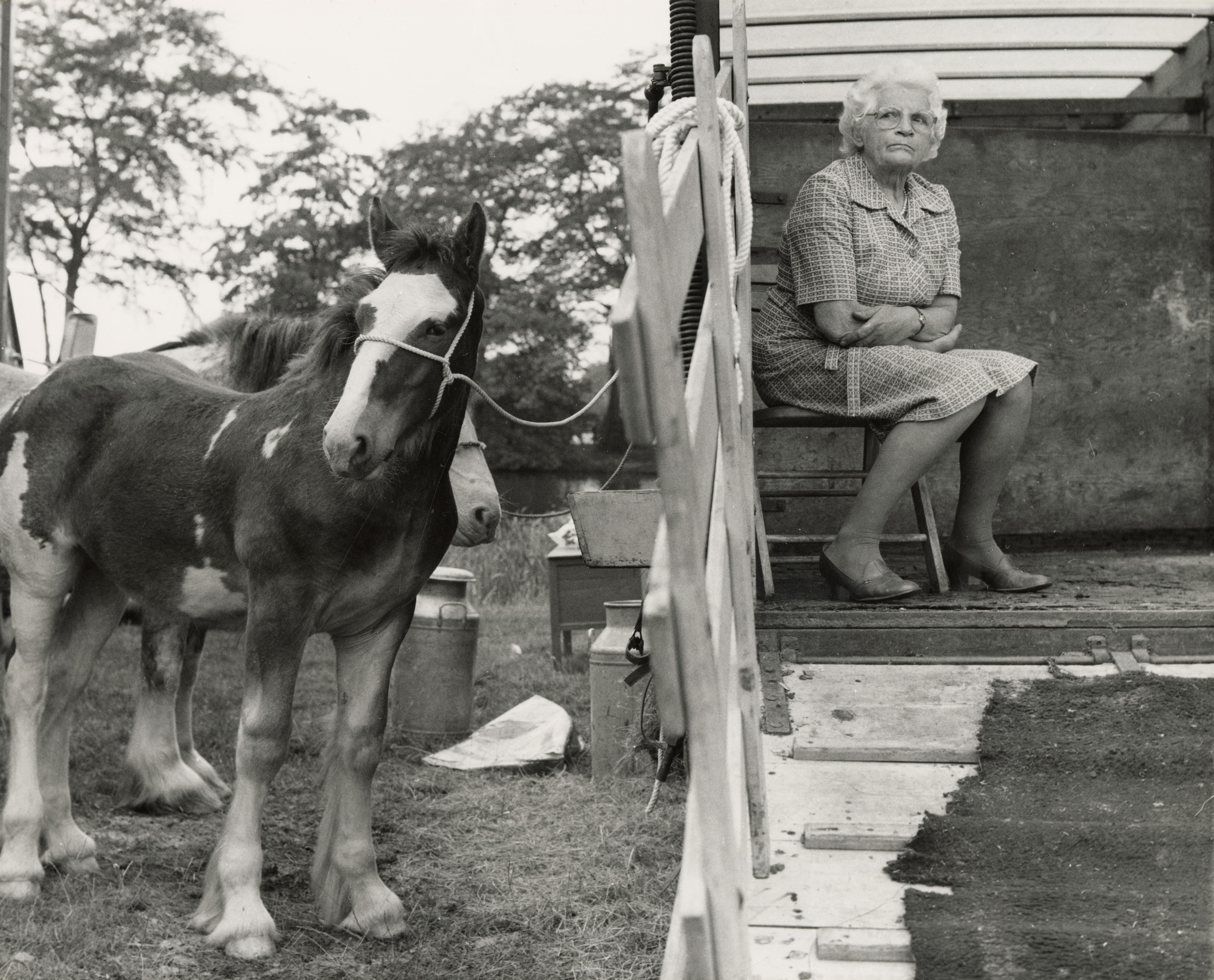Shirley Baker: A Different Age, James Hyman Gallery review - the old at leisure | reviews, news & interviews
Shirley Baker: A Different Age, James Hyman Gallery review - the old at leisure
Shirley Baker: A Different Age, James Hyman Gallery review - the old at leisure
A little-known photographer and an overlooked subject take the spotlight

The note of longing scored into this exhibition’s title is well-judged: as things are now, it is the sight of the elderly in the company of friends, watching the world go by from a doorstep or park bench, that provokes a pang of nostalgia, far more than the surface details of the mid-20th century, when these
Produced in response to the virus, this selection of 20 photographs by Shirley Baker (1932-2014), focuses on her depictions of the elderly, who blossom under her gently satirical gaze. The online exhibition includes examples of Baker’s colour work as well as her preferred black and white, all of which date from 1960-1985 and were taken around Salford and Manchester.
In different times, the exhibition’s focus on our aged population might seem to risk its audience, but the show, co-curated by Baker’s daughter Nan Levy, reveals Baker at her best, the equal of famous contemporaries like Bill Brandt, and a forerunner of Martin Parr’s bittersweet social forensics.
 A Woman on a Bench, c.1965 (main picture), holds two dogs on leads, the three of them all looking distractedly away from each other, each wearing uncannily similar facial expressions. A picture taken at some event at Poynton, Cheshire, 1968 (pictured above), shows a horse tethered to a horsebox, inside which his owner sits on a stool. Both wear puzzled expressions, as if startled by something out of shot, and they mirror each other in a way made all the more absurd by their somewhat reversed roles.
A Woman on a Bench, c.1965 (main picture), holds two dogs on leads, the three of them all looking distractedly away from each other, each wearing uncannily similar facial expressions. A picture taken at some event at Poynton, Cheshire, 1968 (pictured above), shows a horse tethered to a horsebox, inside which his owner sits on a stool. Both wear puzzled expressions, as if startled by something out of shot, and they mirror each other in a way made all the more absurd by their somewhat reversed roles.
Though so often funny, Baker shows us time and again that this tendency to look like others, whether animal or not, is an expression of our humanity, a way for us to connect and empathise with others. In a picture from 1970, two women silently and entirely separately appraise a display of knick-knacks or similar, apparently united in thought and gesture, if not in words. On occasion, Baker’s eye is straightforwardly wicked, and though there are echoes between one set of legs and another, the real point of Untitled Woman and Horse, 1968, is the juxtaposition of a blameless old lady and a horse’s back end.
Signage is also recruited by Baker, adding humour, and an elegant neatness to a view of an open-top car in Chester, parked by what must be the River Dee, its occupant reading a newspaper in oblivious defiance of the signs instructing otherwise.
Baker was a reluctant amateur, unable to join the staff of the Guardian which she said “ran a ‘closed shop’ …, open only to men.” Though we are still largely unfamiliar with her work, Baker is best known for her pictures of northern slums, for which this timely and carefully conceived exhibition offers a valuable corrective.
rating
Explore topics
Share this article
The future of Arts Journalism
You can stop theartsdesk.com closing!
We urgently need financing to survive. Our fundraising drive has thus far raised £49,000 but we need to reach £100,000 or we will be forced to close. Please contribute here: https://gofund.me/c3f6033d
And if you can forward this information to anyone who might assist, we’d be grateful.

Subscribe to theartsdesk.com
Thank you for continuing to read our work on theartsdesk.com. For unlimited access to every article in its entirety, including our archive of more than 15,000 pieces, we're asking for £5 per month or £40 per year. We feel it's a very good deal, and hope you do too.
To take a subscription now simply click here.
And if you're looking for that extra gift for a friend or family member, why not treat them to a theartsdesk.com gift subscription?
more Visual arts
 'We are bowled over!' Thank you for your messages of love and support
Much-appreciated words of commendation from readers and the cultural community
'We are bowled over!' Thank you for your messages of love and support
Much-appreciated words of commendation from readers and the cultural community
 Lee Miller, Tate Britain review - an extraordinary career that remains an enigma
Fashion photographer, artist or war reporter; will the real Lee Miller please step forward?
Lee Miller, Tate Britain review - an extraordinary career that remains an enigma
Fashion photographer, artist or war reporter; will the real Lee Miller please step forward?
 Kerry James Marshall: The Histories, Royal Academy review - a triumphant celebration of blackness
Room after room of glorious paintings
Kerry James Marshall: The Histories, Royal Academy review - a triumphant celebration of blackness
Room after room of glorious paintings
 Folkestone Triennial 2025 - landscape, seascape, art lovers' escape
Locally rooted festival brings home many but not all global concerns
Folkestone Triennial 2025 - landscape, seascape, art lovers' escape
Locally rooted festival brings home many but not all global concerns
 Sir Brian Clarke (1953-2025) - a personal tribute
Remembering an artist with a gift for the transcendent
Sir Brian Clarke (1953-2025) - a personal tribute
Remembering an artist with a gift for the transcendent
 Emily Kam Kngwarray, Tate Modern review - glimpses of another world
Pictures that are an affirmation of belonging
Emily Kam Kngwarray, Tate Modern review - glimpses of another world
Pictures that are an affirmation of belonging
 Kiefer / Van Gogh, Royal Academy review - a pairing of opposites
Small scale intensity meets large scale melodrama
Kiefer / Van Gogh, Royal Academy review - a pairing of opposites
Small scale intensity meets large scale melodrama
 Jenny Saville: The Anatomy of Painting, National Portrait Gallery review - a protégé losing her way
A brilliant painter in search of a worthwhile subject
Jenny Saville: The Anatomy of Painting, National Portrait Gallery review - a protégé losing her way
A brilliant painter in search of a worthwhile subject
 Abstract Erotic, Courtauld Gallery review - sculpture that is sensuous, funny and subversive
Testing the boundaries of good taste, and winning
Abstract Erotic, Courtauld Gallery review - sculpture that is sensuous, funny and subversive
Testing the boundaries of good taste, and winning
 Edward Burra, Tate Britain review - watercolour made mainstream
Social satire with a nasty bite
Edward Burra, Tate Britain review - watercolour made mainstream
Social satire with a nasty bite
 Ithell Colquhoun, Tate Britain review - revelations of a weird and wonderful world
Emanations from the unconscious
Ithell Colquhoun, Tate Britain review - revelations of a weird and wonderful world
Emanations from the unconscious
 Rachel Jones: Gated Canyons, Dulwich Picture Gallery review - teeth with a real bite
Mouths have never looked so good
Rachel Jones: Gated Canyons, Dulwich Picture Gallery review - teeth with a real bite
Mouths have never looked so good

Add comment